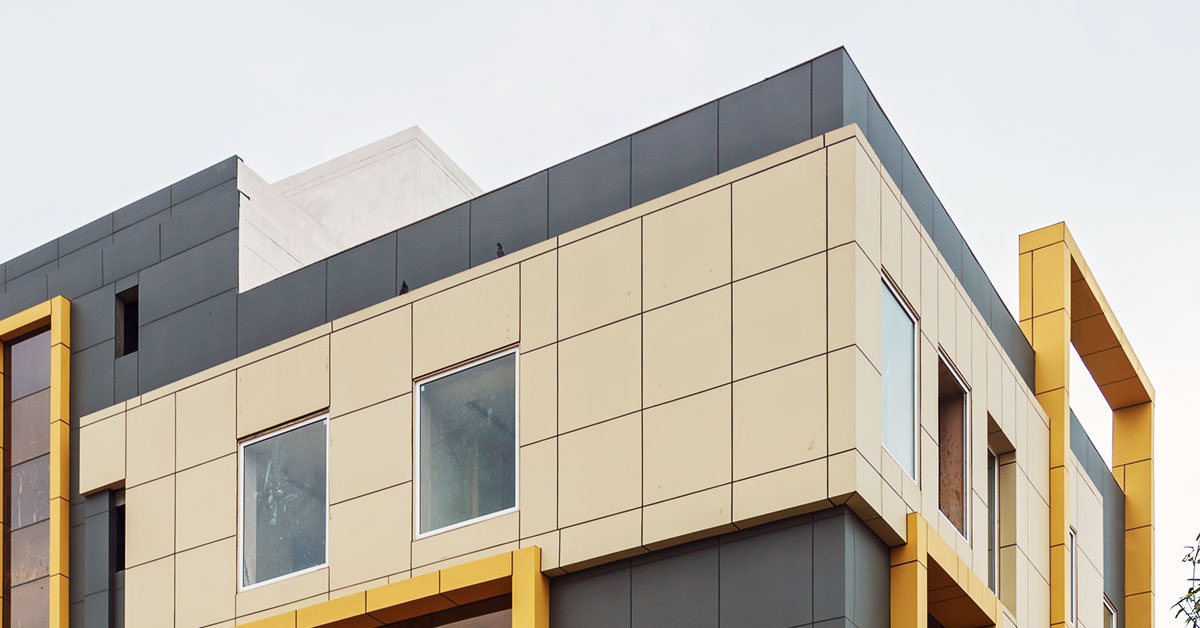1. Introduction
Imagine walking into a building with sleek, modern panels covering its exterior. Odds are, you’re looking at Aluminium Composite Panels (ACPs). ACPs are everywhere – on high-rise buildings, in airports, and even as part of snazzy signage and interior decor. These panels are made for visual appeal, affordability, and durability. But with increasing awareness of fire hazards in construction materials, the question has popped up: Are Aluminium Composite Panels flammable? And that’s exactly what we’re here to unpack.
Now, you might be wondering why this is such a big deal. The sad reality is that fire incidents involving ACPs, like the Grenfell Tower tragedy, have shown just how critical it is to understand the flammability of these materials. Today, we’ll dive into what makes an ACP flammable (or not), the different types of ACPs, and everything you need to know about using them safely. Let’s get into it!
2. Understanding Aluminium Composite Panels (ACPs)
Composition of ACPs
So, what are ACPs made of? Picture a “sandwich” structure: two thin sheets of aluminum with a core material in between. The core is where the real action happens, and it’s usually one of two main types:
- Polyethylene (PE) Core: This is the more common type, and it’s known for being lightweight, cost-effective, and great for indoor use. However, PE is highly flammable, which is why PE-core panels are a bit of a fire hazard.
- Fire-Retardant Core: This core is mineral-filled, reducing flammability and making it safer for exterior use, especially on high-rises. These panels meet stricter fire-resistance standards.
Types of ACPs Based on Core Material
ACPs are classified by their core material:
- Non-Fire-Rated Panels: Typically made with PE cores, these panels are flammable and usually avoid use in high-rise buildings.
- Fire-Rated Panels: These come with a fire-retardant or mineral core, reducing the risk of flames spreading, making them ideal for large commercial and residential buildings.
Common Applications of ACPs in Construction
The popularity of ACPs isn’t just a fad. They’re used in construction all over the world for their versatility and affordability. You’ll see them on building facades, in interior design, and as cladding materials in both residential and commercial projects. People love ACPs because they’re lightweight, weather-resistant, and offer that sleek, modern look that’s hard to beat.
3. Is Aluminium Composite Panel Flammable?
The Role of the Core Material in Flammability
Here’s the kicker: the core of the ACP determines its flammability. PE-core ACPs, due to their plastic composition, can catch and spread flames quickly. Fire-rated ACPs with mineral cores, however, have far lower flammability, making them suitable for places with strict fire codes.
How Aluminium Sheets Affect Fire Behavior
While aluminum itself doesn’t ignite, it does conduct heat. This means that in case of a fire, the metal layer in an ACP could accelerate heat distribution. But the material doesn’t burn – instead, it melts at very high temperatures, which might slow the fire’s spread in the panel, though not entirely stop it.
Testing Flammability in ACPs
Fire testing standards for ACPs are rigorous. The ASTM and EN 13501-1 are the big players in fire testing, with classifications like Class A2 or B1 indicating varying levels of fire resistance. Class A2 panels, for instance, are highly fire-resistant, while Class B1 panels have moderate resistance.
4. Fire Hazards Associated with Non-Fire-Rated ACPs
PE-Core ACPs and Fire Spread
Non-fire-rated, PE-core ACPs are, unfortunately, notorious for spreading fires quickly. They’ve been linked to several high-profile incidents, such as the Grenfell Tower fire in London, where PE-core ACPs contributed to the rapid spread of flames. In such cases, the combination of flammable cores and conductive aluminum sheets turned buildings into fire hazards, prompting sweeping changes in building codes worldwide.
Potential Risks in Residential and Commercial Buildings
Buildings with PE-core ACPs face unique fire risks, especially in multi-story structures. Fire can travel up the facade, bypassing internal fire barriers, and, in some cases, reach adjoining buildings through gaps in ventilation. This risk is heightened in high-density areas and needs to be carefully considered when choosing materials for cladding.
5. Advancements in Fire-Resistant ACPs
Introduction of Fire-Retardant Core Materials
Thankfully, manufacturers have been improving ACP safety by adding fire-retardant mineral cores, significantly reducing flammability and smoke production. These new core materials not only meet fire safety standards but also minimize toxic smoke, providing better safety in high-density buildings.
Industry Standards and Regulations for Fire-Resistant ACPs
Globally, safety standards have evolved to match these advancements. Standards like EN 13501-1 in Europe and NFPA codes in the United States now require specific fire ratings for ACPs used in high-rise or high-occupancy buildings, helping ensure that only the safest materials make the cut for projects where fire risk is a concern.
6. Safety Regulations and Compliance in ACP Usage
Global Fire Safety Standards for ACPs
The rules are clear: to ensure safety, ACPs must meet region-specific regulations. In the EU, regulations focus on classifications like A2 or B1, which inform builders of the level of fire resistance. In the US, the focus is more on NFPA standards, ensuring that all construction materials have sufficient fire resistance.
Compliance Requirements for Builders and Contractors
Contractors and builders bear the responsibility for sourcing ACPs that meet fire-safety standards. Using mislabeled or counterfeit materials can result in severe legal and reputational consequences, not to mention compromised safety for building occupants.
7. Best Practices for Safe Installation and Maintenance of ACPs
Selecting Fire-Rated ACPs for Construction Projects
When it comes to ACPs, not all panels are created equal. For high-rise and commercial buildings, always opt for fire-rated panels. Look for reputable manufacturers and insist on certification to avoid accidentally installing flammable materials.
Installation Considerations for Minimizing Fire Risk
The way panels are installed can impact fire safety. Using fire barriers between panels and ensuring there are no gaps that flames can travel through are crucial steps to make ACP installations safer. It’s all about making sure fire doesn’t have an easy path.
Regular Inspection and Maintenance for Safety
Just as with anything in construction, regular inspections of ACPs are essential. Check for any signs of damage, gaps, or deterioration that might compromise fire safety. Maintenance goes a long way toward keeping both your building and its occupants safe.
8. Alternatives to Aluminium Composite Panels
Overview of Non-Combustible Alternatives
If fire risk remains a concern, there are non-combustible alternatives to ACPs. Materials like solid aluminum panels, fiber cement boards, and steel are all great options that offer similar durability and aesthetics without the flammability.
Choosing the Right Material Based on Building Requirements
Ultimately, the right material depends on your building’s needs. Consider the location, fire-safety requirements, and, of course, budget when deciding between ACPs and alternatives. After all, safety should always be top of mind.
9. Frequently Asked Questions (FAQs)
- Are all Aluminium Composite Panels fire-resistant? No, only panels with fire-rated cores have fire-resistant properties. Standard PE-core ACPs are flammable.
- How can I tell if an ACP is fire-rated? Look for certifications and fire-resistance ratings such as A2 or B1 on the product label.
- What are the regulations for ACPs in my region? Regulations vary, so check local building codes or consult with professionals to understand your region’s specific requirements.
- Is it safe to use ACPs in residential buildings? It depends. Fire-rated ACPs can be safe in many cases, but it’s best to consider building height and occupancy.
- What alternatives are available if I am concerned about ACP flammability? Non-combustible options like solid aluminum panels, fiber cement, or steel panels provide added fire safety.
10. Conclusion
Understanding ACPs’ flammability and safety features is critical. While ACPs are popular for their style and utility, fire-rated versions are essential for high-occupancy or multi-story buildings. As fire safety standards evolve, so do materials, making it easier to find ACPs that balance beauty with safety. When it comes to building materials, let’s keep safety a priority – it’s worth every penny!


Leave a Reply